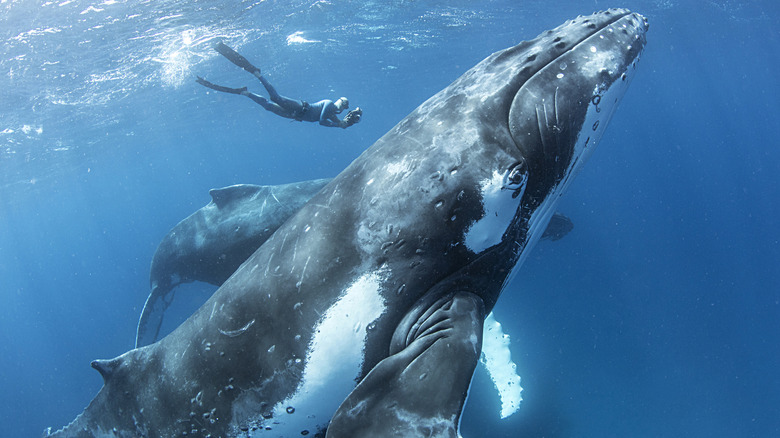This Polynesian Island Nation Is Filled With Verdant Forests, Fiery Volcanoes, And Bright White Beaches
Pristine corners of the world are harder and harder to find, but a chain of volcanic islands rimmed in expansive coral reefs between Hawaii and New Zealand is the visual representation of Paradise — and it's not the typical Polynesian islands you surely have on your bucket list. Known for its sustainable tourism practices, Tonga is a country in Oceania, made up of about 170 islands in the Southwestern Pacific Ocean, of which 36 are inhabited. To the north, the islands are neighbored by Samoa, to the west, Fiji's top-rated and perhaps better-known islands, and to the east, the Cook Islands.
Tonga's rocky, volcanic islands in the west rise up starkly, while on its eastern side, the islands are coral and limestone, offering incredible snorkeling and scuba opportunities (despite an active underwater volcano nearby). Throughout the Tonga archipelago, powdery white beaches reign supreme.
In 1773, British explorer Captain James Cook arrived in Tonga, referring to the nation as the Friendly Islands. Eventually, missionaries came, the country converted to Christianity, and Tonga became an independent Commonwealth nation in 1970. Although Western explorers lauded these islands centuries ago, they remain hidden tropical destinations, in part because of how challenging they are to access. You don't need to try very hard to go off the beaten path in Tonga. It's all, by default, a hidden gem!
Tonga is a wonderland of natural resources and activities
Tonga has three island groups: the southern islands of Tongatapu, the central islands of Ha'apai, and Vava'u in the north. Tongatapu, where most international flights arrive, is one of the main islands in the archipelago and a gateway to the rest of the area. Famously, Tonga — particularly Tongatapu — is one of the only places in the world where you can go swimming with humpback whales in their natural habitat.
Nuku'Alofa is Tongatapu's main hub, and while it's mainly used for transit, there are also a few things worth stopping for, including the Royal Palace, Royal tombs, the Tonga National Cultural Center, and waterfront dining. On Tongatapu, make your way to the Mapu'a'a Vaea to see a series of naturally-eroded blowholes where strong swell can send spurts of water 100 feet into the air. The ancient Ha'amonga 'a Maui is a fascinating structure made of coral and limestone, nicknamed the "Stonehenge of the South Pacific." You can also swim in the Anahulu underground caves or relax at Ha'atafu Beach, a beautiful white-sand retreat with great snorkeling.
Hop over to Vava'u, where you can go hiking at Mount Talau, stay at the Matafonua Lodge for easy access to pristine nature and a gorgeous waterfall, or take a guided kayak tour complete with accommodations. Visit Ha'apai for its untouched beaches and pristine scuba diving and snorkeling. You can also learn about the massive nearby volcano that caused a tsunami in 2022. Trek up Kao, Tonga's highest volcanic peak, for stunning, overlooking views.
'Eua Island in Southern Tonga also has plenty to see and do, including exploring dramatic cliffs, rock formations, isolated white sand beaches flanked by giant, ancient banyan trees — plus, there are activities from four-wheel driving and spearfishing to nature tours and birdwatching in the national park. Keep an eye out for wild horses on the incredible beaches as well.
When and how to get to Tonga
The best time of year to visit Tonga is debatable: May through November has the best weather, as Tonga has a tropical rainforest climate and the northern islands are prone to typhoons from December until about April. If you're trying to swim with whales, July through October is your best bet.
It's important to note that Sundays are strictly observed in Tonga for religious reasons, and many tours, businesses, and even taxis will be closed. Plan ahead, and prepare for your trip so you won't be one of those tourists that drive locals up the wall. Other general must-dos include catching a rugby match, attending church (a whole Tongan experience), and tasting kava, a root-based beverage that originated in this part of the world.
Flying internationally from New Zealand, Australia, or Fiji will probably mean you'll fly into Fua'amotu International Airport on Tongatapu, about 13 miles from the country's capital, Nuku'alofa, which is a major port of call for a number of cruise lines in the South Pacific. There are a few main islands with some tourism infrastructure, at least during high season, and you can access them via flight or ferry from Tongatapu. To Vava'u, it's about a one-hour flight or a 24-hour ferry; to Ha'apai, it's about a 50-minute flight or a 14-hour ferry; and to 'Eua, it's about a 10-minute flight (one of the shortest commercial flights in the world) or a two-hour ferry. On the inhabited islands you can usually get taxis or your accommodations will provide transportation.


